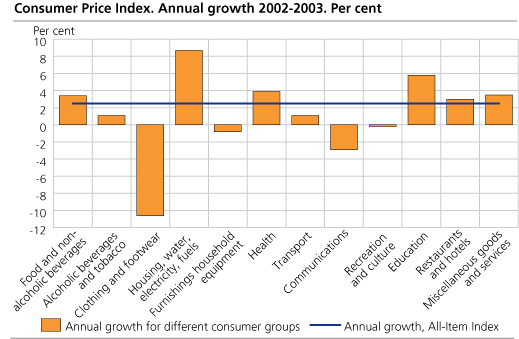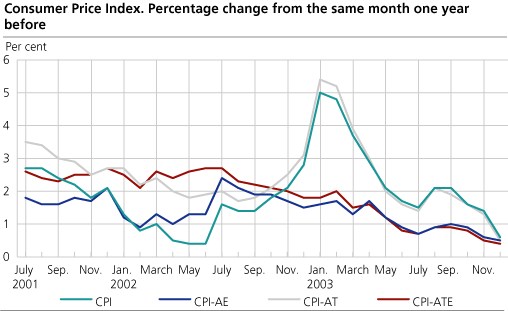Content
Published:
This is an archived release.
Consumer prices up 2.5 per cent in 2003
The Consumer Price Index (CPI) increased by 2.5 per cent from 2002 to 2003. The price increase was mainly caused by a strong rise in the tariffs on electricity. The growth in the CPI excluding electricity was 1.2 per cent in 2003.
From 15 November to 15 December 2003 the consumer prices was unchanged. The CPI stood at 112.6 (1998=100) in December 2003 in comparison with 111.9 in December 2002 - the year-to-year growth in December fell down to 0.6 per cent. CPI was on average 112.8 in 2003.
Annual growth 2003: Higher tariffs on electricity
The CPI increased by 2.5 per cent from 2002 to 2003. The main single contribution to the consumer price growth came from higher tariffs on electricity. Towards the end of 2002 and in the beginning of 2003 the tariffs increased much more than normal, from December 2002 to January 2003 the growth rate was as high as 48.6 per cent. The electricity prices increased much more than the cost of transporting energy. The consumption tax on electricity increased from NOK 9.3 to 9.5 øre/kWh. In the following months the tariffs fell - in the period January - July the tariffs fell altogether by 44.8 per cent. In August and September the prices jumped up again by 11.9 and 5.2 per cent respectively. Towards the end of the year the tariffs increased less compared with the same period the year before. On average the tariffs on electricity rose by 36.6 per cent from 2002 to 2003. The growth in the CPI excluding electricity was 1.2 per cent while the CPI excluding energy products (CPI-AE) came down to 1.0 per cent in 2003.
Higher rentals also contributed to the growth in the consumer prices from 2002 to 2003. The costs for owner-occupied housing and rentals for housing rose by 4.1 and 4.0 per cent respectively.
The prices of food and non-alcoholic beverages went up 3.4 per cent in 2003. The vegetable prices, which increased by 7.0 per cent, were among the main contributors.
The prices of several services increased considerably in 2003. Insurance premiums rose by 7.9 per cent and the prices of different services connected to health increased on average by 6.4 per cent. Other services that have increased more than the average price growth were primarily the prices of passenger transport by road, restaurant services and educational expenses.
The prices of clothing have in a number of years shown a falling tendency and the clothing prices continued to decrease in 2003. With an average decline of 11.8 per cent the prices were the main contributor to dampen the consumer price growth from 2002 to 2003. The prices of audiovisual equipment fell in the same period by 8.5 per cent. The airline fares also dampened the consumer price growth with a decline of 6.4 per cent in 2003. The same did the prices of package holidays and telephone equipment.
The growth in the CPI adjusted for tax changes and excluding energy products (CPI-ATE) was 1.1 per cent in 2003 while the CPI adjusted for tax changes (CPI-AT) increased, like the CPI, by 2.5 per cent.
No change in the CPI from November to December
The consumer prices showed no change from November to December. This was also the case for the CPI-AE. The tariffs on electricity increased by 2.8 per cent in December, while the petrol prices on the other hand declined by 2.4 per cent.
The prices of transport services as a total went down 1.1 per cent from November to December. The airline fares fell 3.8 per cent, while the taxi fares went up since last survey.
Year-to-year change of 0.6 per cent
The year-to-year change in the CPI was 0.6 per cent in December. The low growth rate can be explained by a price decline of clothing of 13.3 per cent from December 2002 to December 2003. The year-to-year change in the CPI went from 1.4 per cent in November to 0.6 per cent in December, mainly due to a drop in the year-to-year growth in the electricity prices compared with previous months. The tariffs on electricity increased by 3.8 per cent from December 2002 to December 2003, which is the lowest growth rate since October 2002. The petrol prices along with the airline fares have contributed to the drop in the year-to-year change as well.
The year-to-year change in the CPI-AE went from 0.6 per cent in November to 0.5 per cent in December, while the CPI-ATE declined from 0.5 to 0.4 per cent in the same period.
| The Consumer Price Index. 1998=100 |
| Index | Change in per cent | ||||||||||||||||||||||||||||||||||||||
|---|---|---|---|---|---|---|---|---|---|---|---|---|---|---|---|---|---|---|---|---|---|---|---|---|---|---|---|---|---|---|---|---|---|---|---|---|---|---|---|
| December 2003 |
November-
December 2003 |
December 2002-
December 2003 |
Annual growth
2002-2003 |
||||||||||||||||||||||||||||||||||||
| CPI All-item index | 112.6 | - | 0.6 | 2.5 | |||||||||||||||||||||||||||||||||||
| Food and non-alcoholic beverages | 105.2 | 0.2 | 3.4 | 3.4 | |||||||||||||||||||||||||||||||||||
| Alcoholic beverages and tobacco | 112.8 | 0.2 | -0.7 | 1.1 | |||||||||||||||||||||||||||||||||||
| Clothing and footwear | 78.6 | - | -11.9 | -10.6 | |||||||||||||||||||||||||||||||||||
| Housing, water, electricity, fuels | 130.5 | 0.6 | 3.4 | 8.7 | |||||||||||||||||||||||||||||||||||
| Furnishings household equipment | 101.9 | -0.3 | -1.1 | -0.8 | |||||||||||||||||||||||||||||||||||
| Health | 122.6 | -0.5 | 4.3 | 3.9 | |||||||||||||||||||||||||||||||||||
| Transport | 112.3 | -0.6 | -0.4 | 1.1 | |||||||||||||||||||||||||||||||||||
| Communications | 84.0 | -0.5 | -5.6 | -2.9 | |||||||||||||||||||||||||||||||||||
| Recreation and culture | 104.5 | -0.2 | -0.9 | -0.2 | |||||||||||||||||||||||||||||||||||
| Education | 141.1 | - | 7.3 | 5.8 | |||||||||||||||||||||||||||||||||||
| Restaurants and hotels | 120.9 | -0.1 | 2.7 | 3.0 | |||||||||||||||||||||||||||||||||||
| Miscellaneous goods and services | 119.4 | 0.1 | 3.0 | 3.5 | |||||||||||||||||||||||||||||||||||
| CPI-AE | 110.0 | - | 0.5 | 1.0 | |||||||||||||||||||||||||||||||||||
| CPI-AT | - | 0.5 | 2.5 | ||||||||||||||||||||||||||||||||||||
| CPI-ATE | - | 0.4 | 1.1 | ||||||||||||||||||||||||||||||||||||
Contact
-
Statistics Norway's Information Centre
E-mail: informasjon@ssb.no
tel.: (+47) 21 09 46 42
-
Konsumprisindeksen
E-mail: konsumprisindeksen@ssb.no
tel.: (+47) 62 88 56 34
-
Camilla Rochlenge
E-mail: camilla.rochlenge@ssb.no
tel.: (+47) 40 90 23 72
-
Kjersti Nyborg Hov
E-mail: kjersti.nyborg.hov@ssb.no
tel.: (+47) 40 90 23 63
-
Gunnar Larsson
E-mail: gunnar.larsson@ssb.no
tel.: (+47) 40 90 26 79
-
Trym Kristian Økland
E-mail: trym.okland@ssb.no
tel.: (+47) 46 81 09 15


